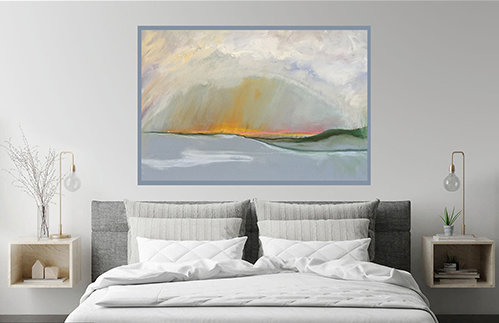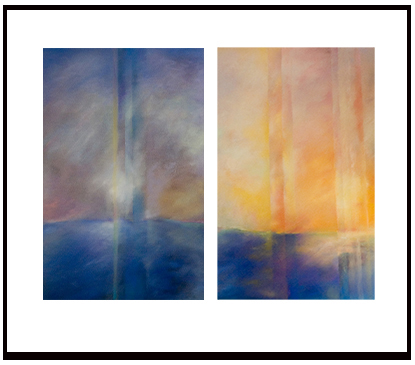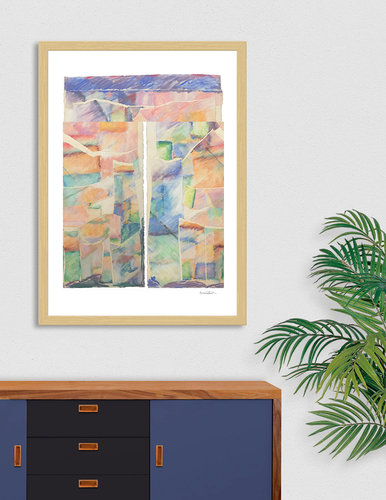How Designers Select Art for Interiors
Artist and color consultant Barbara Jacobs shares insights about working with designers and their clients.

“Stories of Storms” pastel, by artist Barbara Jacobs
AS: What should artists know about design professionals? How do they make decisions about art?
BJ: We know that design professionals work with color all the time. Maybe it’s redundant to mention, but if you think about it, they are directly involved in many ways with every product and every material they specify or purchase for their clients. This, of course, often includes recommending and acquiring artwork, including both originals and reproductions.
If you want to work with design professionals, it’s helpful to try to see things from their side of a project. Try to gain understanding about how a designer chooses artwork that complements and even notably enhances their own creative work. A few things to consider, and even ask the designer about, are:
- Is the artwork something to simply fill in a space, or does it really lift the ultimate design to a higher level?
- Is a selected art piece based on stated client preferences?
- What is the designer’s approach to using art? For example, more expensive art designated to accompany the more costly living areas?
- Is the area for artwork more casual or more formal? (even casual areas can be sophisticated.)
- Is the designer looking for a work that is strong? How do they define that quality, and where do they see using such work?
- Could it be based on a designer’s favorite artist, or on the “latest and greatest”?
- Is the designer looking for a piece to complement the owner’s collections and carpets?
- Is the designer is looking for a new artist, or a fresh approach to a particular subject?
- Do designers select art to match the colors they are using?
- If so, what do they mean by match?
- Are they using art as the starting point for the design + color palette? Or, is the art selection a finishing touch?
- To what degree is budget a factor?
Ideally, the art selected should engage the client on an emotional, visceral level. In addition, it must fill the requirement that the designer has in mind (that’s the artist in me speaking!) We as artists can help educate design professionals as well as learn more about their processes. This happens when we engage with them in conversations about how to best serve clients.
Design professionals appreciate and value original artwork. But since actually creating artwork is typically not their focus, it’s up to us as artists to help them understand our art-creating processes.

Commissioned diptych, “Mystic Sunrise, Mystic Sunset” pastel, by artist Barbara Jacobs
AS: What about client commissions?
BJ: Commission work is another story. I’ve worked with designers and directly with clients on these projects. The subjects of color and themes/images can become the major focus, so it helps to be open to that, to a certain extent.
I believe that as the artist, you should retain the final say about composition and other artistic elements. After all, that’s why they come to us in the first place. During the commission process, I’ve had to explain why I made certain choices along those lines. I did not really mind it since I felt it was not justifying my choices, but rather educating the designer and the client. In my experience, they appreciate this type of information.
At one time I was asked by a designer and her client to comment on a pastel landscape they were considering from another artist. I remarked on the many beautiful qualities, but asked “Why aren’t you sure about it even though you like the painting?” It turns out they wanted to see specific trees in the landscape and were surprised the artist did not want to change it.
Asked what I would do under the circumstances, I told them artists have individual reasons for creating composition in particular ways. I added that I would feel the same way about making changes. However, if they wanted to commission a piece with certain elements, we would follow a specific process and remain in agreement throughout. I said I would retain the final say on composition, etc. and not just add items simply because they were requested. There is a reason why my work is done in a particular way. They agreed; we met at various points during the process, with a happy outcome.

“Structures In Light” pastel collage by artist Barbara Jacobs
AS: How do you imagine your own artwork fitting into interior spaces? What clues do you look for, given client preferences?
BJ: I typically work from an instinctive place rather than making purposeful decisions about using colors that comply with trends. Yet, because my work as a color consultant takes me into many different types of homes and businesses, for both interior and exterior projects, I’m exposed to this subject in a way that can sometimes unconsciously link to my personal artwork. I always keep an open mind about which pieces of my work will fit with a client’s space and preference. Often, clients appreciate when I make timely suggestions and show them my own vision of possibilities. I will bring a few pieces with me to an appointment, or arrange a studio visit so they can view my inventory.
Clues come from observation and discussion. If my own work is not a fit for them, I might know another artist whose work they would love. For example, I did all types of surface finishes, including murals and Venetian Plaster, for about 25 years. When I moved away from that work, I was and am always happy to refer other artists.
Learn more about Barbara Jacobs by visiting her art website. Link to Carolyn’s original article here.
